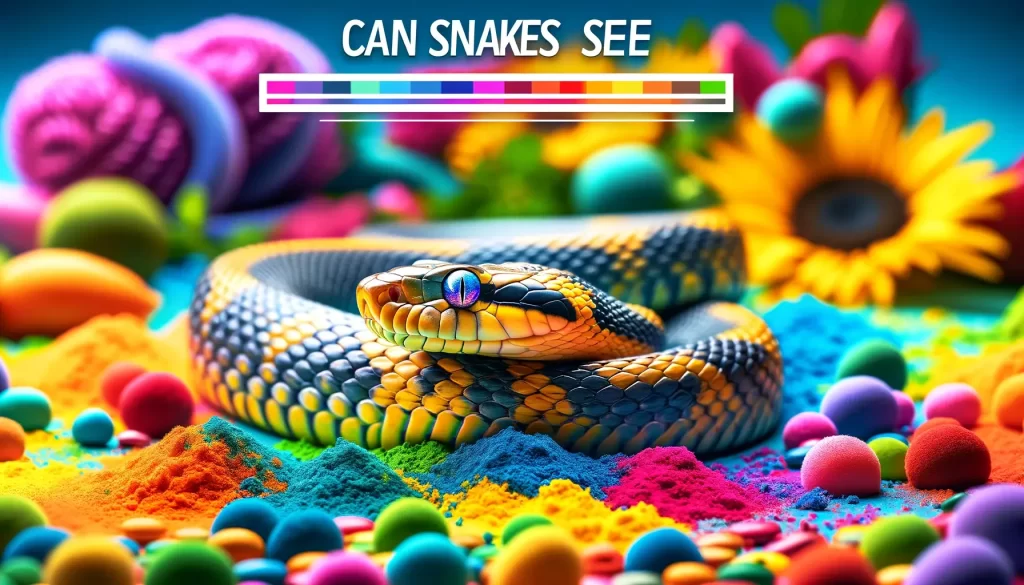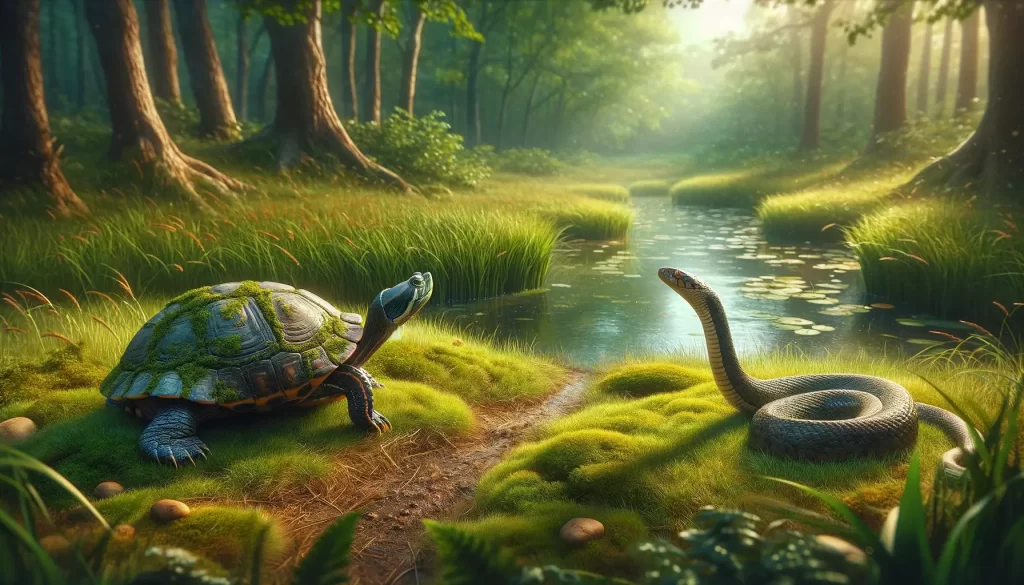
You’re about to uncover the truth behind a fascinating question: Can snakes see color? We’ve all heard the tales of snakes with their sinister, darting eyes, but do they perceive the world in shades of black and white or can they appreciate the vivid hues that surround them?
This article will unravel the mysteries of the snake’s visual abilities and shed light on their colorful perception of the world.
Get ready to discover the surprising truth about how these slithering creatures see color.
Snakes’ Vision Compared to Humans
Have you ever wondered how snakes perceive the world around them? Their vision differs greatly from that of humans, largely due to the variation in their photoreceptor cells and the specific adaptations they have developed over time.
Understanding the differences in snake vision can give us a fascinating glimpse into their unique way of perceiving their surroundings and interacting with their environment.
Types of Photoreceptors in Human Eyes
In order to appreciate the distinctions in snake vision, it is important first to understand the types of photoreceptor cells found in human eyes.
Humans possess two types of light-sensitive cells: rods and cones. Rods are responsible for vision in low-light conditions and aid in peripheral vision, while cones allow for color vision and visual acuity in bright light.
The cones come in three forms, each sensitive to a different range of colors: red, green, and blue.
Differences in Snake Eyes
Snakes, on the other hand, have a different arrangement of photoreceptor cells. While they also possess rods and cones, their vision is not as highly developed as that of humans.
Snakes have a higher number of rods than cones, which enables them to have excellent night vision capabilities.
This abundance of rods allows them to detect movement and shapes even in very dim light conditions.
However, as a trade-off, they have limited color vision compared to humans.
Limitations of Snake Vision
The limited color vision of snakes can be attributed to their fewer numbers of cones and the absence of certain types of color-sensitive cones found in humans.
While humans can perceive a wide range of colors due to the presence of red, green, and blue cones, snakes see colors on a much more limited spectrum.
Their color vision is primarily limited to shades of blue and green, and they struggle to distinguish between reds and oranges.
This is because snakes lack the cones necessary for perceiving longer wavelengths of light.
Types of Photoreceptors in Snake Eyes
To better understand how snakes perceive their environment, it is important to delve into the types of photoreceptor cells in their eyes.
Similar to humans, snakes possess both rods and cones. However, the proportions and characteristics of these photoreceptors differ, allowing snakes to excel in certain aspects of vision.
Color-sensitive cones
Snakes have a small number of color-sensitive cones compared to humans. Instead of three types of cones, they only have two types: ultraviolet-sensitive (UV) cones and green-sensitive cones. These cones enable snakes to perceive differences in light wavelengths, but their color perception is limited to a relatively narrow range compared to humans. Snakes are unable to see the full range of colors that humans can, particularly colors on the red end of the spectrum.
Low light-sensitive rods
One unique feature of snake vision is their abundance of rods, which are responsible for vision in low-light conditions. The high number of rods in their eyes allows them to see exceptionally well in dimly lit environments, giving them a notable advantage at night. The rods in snake eyes are highly sensitive to movement and can detect even subtle changes in their surroundings. This evolutionary adaptation has allowed many snake species to become successful nocturnal predators.
Snake Vision in Dim Light
Snakes have evolved to thrive in various environmental conditions, including those with limited light. Their vision in dim light conditions is an incredible adaptation that enables them to hunt and survive during the night.
Nocturnal species
Many snake species are nocturnal, meaning they primarily come out and hunt during the night. This is because their eyes are well-adapted to low-light conditions, allowing them to spot prey and navigate their surroundings effectively. Nocturnal snakes have a greater density of rods in their eyes, giving them enhanced vision in the dark. This allows them to exploit the cover of darkness to stealthily hunt and capture their prey.
Infrared detection
Some snake species, such as pit vipers, possess a unique ability to detect infrared radiation. These snakes have a specialized organ called the pit organ, located between their eyes and nostrils. The pit organ contains heat-sensitive receptors, known as infrared receptors, which allow the snake to sense the thermal radiation emitted by warm-blooded animals. This incredible adaptation grants pit vipers an additional sense that assists them in hunting prey, even in complete darkness.
Pupil dilation for better low-light vision
Another fascinating aspect of snake vision in dim light is their ability to dilate their pupils. Snakes can alter the size of their pupils in response to changes in light intensity. In darker conditions, their pupils dilate, allowing more light to enter their eyes and improving their vision. This dilation of pupils helps them to make the most of the available light and enhance their ability to spot prey and potential threats in low-light environments.
Understanding Snake Color Perception
While snakes may not have the same extensive color vision as humans, they still possess some level of color perception. Understanding how snakes perceive color can shed light on their behavior, as well as their interactions with the environment and other organisms.
Colors snakes can perceive
Snakes have the ability to perceive certain colors, albeit with limited accuracy compared to humans. While they may not discern the full range of colors visible to humans, snakes can perceive shades of blue and green relatively well. These colors are within the range of their visual sensitivity and are likely important for their survival and interactions with their surroundings.
Behavioral responses to specific colors
Research suggests that snakes may exhibit behavioral responses to specific colors. For example, some snake species have been observed to show a stronger aggression response towards bright red or orange colors, possibly due to associations with warning signals in nature. This indicates that despite their limited color vision, snakes are still capable of discriminating between different colors and responding accordingly.
Prey attraction to color
Colors can also play a role in snake predation. Certain snake species, such as the green tree python, rely on their coloration to blend in with their surroundings and ambush unsuspecting prey. These snakes have evolved vibrant green coloration, allowing them to blend seamlessly into the foliage. By carefully selecting their resting positions and adopting the appropriate colors, these snakes can surprise their prey and increase their chances of successful predation.
Snake Color Vision Studies
To gain further insights into snake color vision and perception, researchers have conducted various studies and experiments to investigate their visual capabilities.
Research methods and experiments
Researchers have explored snake color vision using multiple methods, including behavioral experiments conducted in controlled laboratory settings. These experiments typically involve presenting snakes with various visual stimuli and observing their responses. For example, researchers have used colored stimuli on computer screens to assess snakes’ ability to discriminate between different colors or react to specific color patterns.
Results and findings
The results of these studies have provided valuable insights into snake color vision. Although the research is ongoing, it generally suggests that snakes have limited color discrimination abilities compared to humans. However, their visual system is well-adapted to their natural environment, and they are capable of perceiving and responding to certain colors in their surroundings.
Evolutionary Reasons for Snake Color Vision
The limited color vision of snakes has significant evolutionary implications. Understanding the reasons behind snake color vision can help illuminate how this unique trait has evolved and the advantages it confers upon these fascinating creatures.
Importance of color vision in hunting
Color vision serves as a vital tool for many predators, aiding them in locating and capturing their prey. Although snakes’ color perception is limited, it still plays a crucial role in hunting. The ability to differentiate between different shades of green and blue may assist snakes in identifying prey items that blend into their surroundings. Snakes may also rely on visual cues from prey, such as color patterns and movement, to determine the best strategy for capturing them.
Camouflage adaptation
Many snakes possess exquisite camouflage adaptations, allowing them to blend seamlessly into their surroundings. Limited color vision allows them to match their coloration more effectively, making it harder for predators and prey to detect them. By having a color perception that aligns with their natural environments, snakes can effectively camouflage themselves and increase their chances of avoiding predation or capturing prey.
Communication and mating behavior
Color vision may also be significant in communication and mating behavior among snake species. Some snake species display vibrant and distinct coloration during courtship rituals. The ability to perceive and respond to certain colors may play a role in mate selection, as well as conveying important information to potential mates. Color patterns and brightness are often used to signal dominance or attractiveness, facilitating successful reproduction among snakes.
Adaptive Advantages and Disadvantages
The unique characteristics of snake vision, including their color perception, provide them with a range of advantages in their natural habitats. However, like any visual system, snake vision has its limitations and trade-offs.
Benefits of color vision for snakes
Although snakes’ color vision is restricted compared to humans, it still offers them several advantages. The ability to perceive colors within their limited range, such as shades of green and blue, assists in their interactions with their environment. This can aid in predator avoidance, camouflage, and prey detection. By being able to distinguish between different shades and patterns, snakes can enhance their hunting strategies and increase their chances of survival.
Visual limitations and trade-offs
While snakes’ vision offers unique advantages, there are also limitations and trade-offs. The limited range of color vision means that snakes may struggle to differentiate between certain colors that humans can readily perceive. Additionally, their reliance on rod cells for low-light vision can reduce visual acuity compared to humans, particularly during brighter conditions. However, these limitations are compensated for by their heightened sensitivity to movement and their ability to detect prey and threats using other sensory cues, such as vibrations and chemical signals.
Comparing Snake Vision Across Species
Snake vision exhibits significant variations across species, reflecting the diverse ecological niches snakes occupy and the selective pressures they face.
Variations in color perception between species
Different snake species demonstrate variations in their color perception abilities. While some species possess more color-sensitive cones and a wider color range, others have more limited color vision. These variations likely reflect the specific demands and challenges of their particular habitats and lifestyles. Snakes in environments with dense vegetation, for example, may have greater color perception to facilitate camouflage and prey detection.
Ecological factors influencing vision
The ecological factors that influence snake vision can include habitat type, prey preferences, and activity patterns. Snakes that inhabit environments with complex vegetation and rely on camouflage for hunting may have more nuanced color perception. Conversely, snake species that primarily rely on other senses, such as heat-sensitive organs or vibration detection, may have reduced color perception. Evolutionary pressures from predators, prey, and environmental conditions contribute to the diverse range of snake vision adaptations seen in different species.
Snake Vision in Human Environment
The human environment presents a unique set of challenges for snake vision, as it introduces objects and colors that may not exist in their natural habitats.
Challenges of perceiving color in human-made objects
The introduction of human-made objects, structures, and colors can pose difficulties for snakes when navigating within human environments. Their limited color vision may make it more challenging for them to distinguish between objects or identify potential threats. For example, snakes may struggle to perceive the red lights on certain devices or the orange cones used for traffic control. This can potentially lead to instances of snakes inadvertently interacting with human structures or being more prone to human-wildlife conflicts.
Effect on snake behavior and survival
The impact of the human environment on snake behavior and survival is a growing area of research. Understanding how snakes adapt to these environments can provide insights into their ability to respond to novel sensory stimuli and the potential consequences of altered visual perception. Further studies are needed to unravel the complexities of snake vision in human-altered landscapes and determine the long-term effects on snake populations.
New Insights and Future Research
As research methods and technologies continue to evolve, scientists are uncovering new insights into snake vision. These discoveries pave the way for future investigations and highlight potential areas of study.
Emerging technologies for studying snake vision
Advancements in technologies, such as high-resolution imaging and neurophysiological techniques, offer exciting opportunities to delve further into snake vision. These tools allow researchers to examine the neural mechanisms involved in snake vision and gain a deeper understanding of the visual processing pathways. Additionally, advancements in genetic research may aid in unraveling the specific genes and genetic adaptations involved in snake vision, providing further insights into its evolution and mechanisms.
Unanswered questions and potential areas for further study
While significant progress has been made in understanding snake vision, many questions remain unanswered. One area of interest is the precise mechanisms by which snakes perceive and interpret color in their surroundings. Further research into the neural processing of visual information in snakes can provide valuable insights into the specific adaptations and limitations of their visual system.
Another intriguing avenue for future research lies in the ecological consequences of altered color perception in human-altered landscapes. By examining the behavioral responses and survival rates of snakes in environments with different color stimuli, scientists can gain a better understanding of how snakes adapt and navigate human-modified habitats.
In conclusion, snake vision is a fascinating topic that highlights the diversity of visual systems in the animal kingdom. Understanding the unique adaptations and limitations of snake vision allows us to appreciate the various strategies snakes have evolved to perceive and interact with their environment. As research continues, scientists uncover new insights into snake vision, shedding light on the incredible adaptations and complexity of these incredible creatures.



